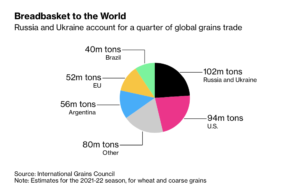The USDA is projecting that the ag trade deficit will shrink in FY2026 even more than previously anticipated. USDA expects the trade deficit to fall from $43.7 billion in FY2025…
Ukraine March Grain Exports Four Times Less than February
Reuters writer Pavel Polityuk reported yesterday that, “Ukrainian grain exports in March were four times less than February levels, due to the Russian invasion, the economy ministry said on Sunday.
“March grain shipments overseas included 1.1 million tonnes of corn, 309,000 tonnes of wheat, and 118,000 tonnes of sunoil, the ministry added.”
Polityuk noted that, “Ukraine was the world’s fourth-largest grain exporter in the 2020/21 season, according to International Grains Council data, with most of its commodities shipped out via the Black Sea.
“But with war raging along much of the coast, traders are being forced to transport more grain by rail.”
Meanwhile, Associated Press writer Samy Magdy reported on Saturday that, “With Russia’s invasion of Ukraine, however, millions of people in the Middle East are now wondering where their next meals will come from.
The skyrocketing prices are affecting people whose lives were already upended by conflict, displacement and poverty from Lebanon, Iraq and Syria to Sudan and Yemen.
“Ukraine and Russia account for a third of global wheat and barley exports, which Middle East countries rely on to feed millions of people who subsist on subsidized bread and bargain noodles. They are also top exporters of other grains and sunflower seed oil used for cooking.
“Egypt, the world’s largest wheat importer, has received most of its wheat from Russia and Ukraine in recent years. Its currency has now also taken a dive, adding to other pressures driving up prices.”

The AP article pointed out that, “In Iraq, the start of Ramadan highlighted widespread frustration over a meteoric rise in food prices, exacerbated in the past month by the war in Ukraine.”
In a look at domestic food price variables, Wall Street Journal writer Patrick Thomas reported in today’s paper that, “A rapidly escalating bird-flu outbreak in the U.S. is contributing to a surge in egg prices and threatens to raise prices on other poultry products in the coming months as deaths continue to mount.
“Cases of highly pathogenic avian influenza so far have led to the deaths of more than 17 million birds, according to Agriculture Department data. The virus outbreak, the worst in seven years, is hitting Midwest egg-laying flocks and affecting companies from Tyson Foods Inc. to Hormel Foods Corp. More than 11 million egg-laying chickens, roughly 3% of the total U.S. flock, have died or been destroyed as a result of the disease, along with more than two million commercially raised turkeys.
“Shell egg prices have climbed to $2.88 a dozen, up about 52% since Feb. 8, when the USDA confirmed the first case in a U.S. commercial turkey flock in Indiana. It is their highest point since the start of the pandemic in March 2020, according to market research firm Urner Barry.”
Thomas explained that, “Prices are being driven higher by the disease’s spread and the coming Easter holiday, when demand for eggs is high, analysts said. Industry officials aren’t expecting any shortages, but analysts said retailers are buying up eggs in anticipation that supplies could tighten in the coming weeks.”
Today’s Journal article added that, “The bird-flu outbreak comes as food prices are already on the rise, with food makers paying more for fuel, ingredients and labor. Analysts said it can be difficult to pinpoint how much prices of certain protein products have been affected by the bird flu because of other inflationary pressures. The war between two grain-producing powers, Russia and Ukraine, is further inflating meat prices as producers rely heavily on grain to feed livestock and poultry.”
Neil Vigdor penned a “Q and A” overview of the bird flu outbreak in today’s New York Times, and noted that, “Egg prices soared when an outbreak ravaged the United States in 2014 and 2015. Recently, the average price of premium large white eggs has been ‘trending sharply higher,’ according to a March 25 national retail report released by the U.S.D.A. If infections course through more flocks, experts said, there could be some shortages of eggs. Prices for white and dark chicken meat were also rising, according to the U.S.D.A. Experts also warned that turkey prices could also become more volatile.”
And the Associated Press reported yesterday that, “Another 15,0000 chickens and 37,000 turkeys will have to be killed after bird flu spread to two more Iowa farms, state agriculture officials announced Sunday.
“Since the outbreak began a month ago, millions of fowl have been killed, many of them in Iowa, which is the nation’s leading egg producer. The latest cases were at a commercial turkey flock in Sac County and in a flock of commercial breeding chickens in Humboldt County.
“Because the virus is so infectious and deadly for commercial poultry, entire flocks are destroyed and composted on the farms when they are infected.”





